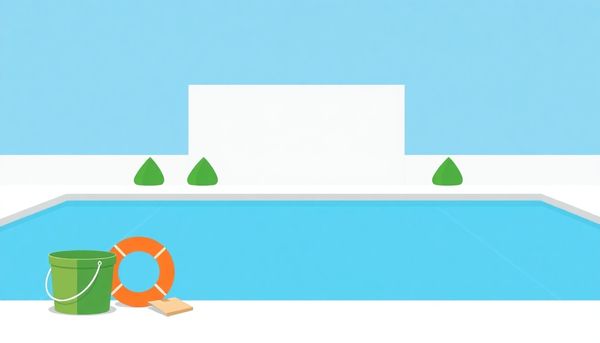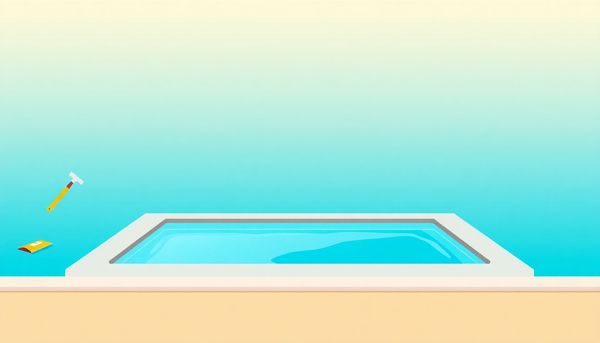Essential Pool Plaster Repair Tips: DIY vs. Professional Help
April 04th, 2024
April 04th, 2024
The serene surface of a well-kept pool can be a subtle reminder of summer leisure, but beneath that calm exterior, there may lurk cracks and blemishes in the plaster that demand attention. Growing up, my family’s pool was the neighborhood gathering spot, a sparkling oasis that required constant upkeep. I remember watching my father meticulously inspect every inch of it, noting even the smallest imperfections. Each crack was more than just a cosmetic issue; it had the potential to lead to leaks or structural damage if neglected.
For those who find themselves facing similar issues, understanding the nuances of pool plaster repair can be invaluable. Whether your pool stands empty or remains filled, the approach to fixing these problems can differ significantly. It’s not just about slapping on some patch; it involves knowing the right materials, employing proper techniques, and ensuring the integrity of your watery haven.
The challenge often lies in deciding when to tackle the repairs. An empty pool allows for easy access and thorough work, making it ideal for significant repairs. On the other hand, fixing plaster while the pool remains full is a delicate dance, requiring specialized tools and techniques to maintain water balance and avoid further damage. Navigating these options, one can restore the pool’s beauty and ensure many more seasons of enjoyment.

When it comes to maintaining your pool, safety should be your primary concern, especially when tackling plaster repairs. Picture this: you’re ready to dive into fixing those unsightly cracks and chips, armed with tools that would make a carpenter nod in approval. Now, while enthusiasm is commendable, handling grinders, concrete saws, and potent acids is not a casual affair. A friend of mine once decided to tackle his pool repairs alone, only to end up with more than just a plaster mishap—a trip to the ER reminded him that some tasks are best approached with caution.
Start by ensuring you have protective gear: gloves, goggles, and a mask are non-negotiable. If power tools are involved, understanding their operation is critical; missteps can lead to severe injuries. For those feeling a bit unsure, remember that calling in a professional doesn’t mean admitting defeat—it’s simply prioritizing wellbeing over DIY bravado.
Moreover, assess the extent of the damage before making your plan. Small repairs might just need underwater putty or plaster mix, letting you work without emptying the pool. However, if the job looks more like an overhaul, draining the pool becomes a necessity. In such cases, be meticulous in following the guidelines to prevent any structural damage to your pool.
Ultimately, your safety comes first. A pristine pool finish is magnificent, but not at the cost of personal harm. Be wise, work smart, and maybe even rope in a buddy to help keep things steady.
Repairing pool plaster requires a careful selection of tools, akin to a chef ensuring they have the right ingredients before preparing a complex dish. Before you embark on this maintenance journey, gather the essentials that will help you navigate the task smoothly.
First, ensure you have a sturdy pair of safety goggles and gloves. Working with plaster and concrete can be hazardous, and protecting yourself is paramount. Next, an angle grinder equipped with a diamond blade will be your trusted ally in cutting away old plaster, especially if you're dealing with significant damage. Supplement this with a concrete saw if you anticipate larger sections needing removal.
A chisel and hammer might sound rudimentary, yet they’re indispensable for chipping away smaller areas of loose plaster without breaching the healthy surface beneath. A mixing paddle and bucket will be crucial for achieving the correct consistency of your plaster mix, ensuring it bonds well to the existing structure.
For underwater repairs, specialized underwater putty and plaster mix are essential. This unique compound cures underwater, allowing you to address cracks without draining your pool. Additionally, a trowel will help you apply these materials smoothly, leaving a seamless finish.
Finally, don't underestimate the importance of a good quality patching compound specifically designed for pools. It ensures a lasting repair, resistant to both water and chemicals found in pool environments. Having these tools at hand will make your repair project less daunting, letting you focus on the task with confidence and precision.
Before grabbing your tools and donning your repair hat, it's crucial to prioritize your safety above all things. Pool plaster repair, though manageable, involves working with potentially hazardous materials and equipment. Consider the time when I tried to fix a minor crack in my pool's plaster. I thought I could handle a concrete saw without a hitch. Spoiler: I couldn’t. A small slip was a loud reminder that safety gear isn’t optional—it’s essential.
First, ensure you have protective eyewear to guard against dust and debris, and gloves to prevent skin irritation from chemicals. Even if you’re the type who balks at wearing a helmet, a sturdy one could shield you from a nasty bump while maneuvering heavy tools. Footwear should never be overlooked; non-slip shoes are your best friend on the sometimes-slippery tiles surrounding a pool.
Moreover, avoid working alone when using heavy equipment or corrosive materials. It's always safer to have someone nearby who can lend a hand or call for help if needed. If you’re ever uncertain about your ability to safely handle the task, don’t hesitate to hire a professional. Your safety is more valuable than the cost of repair. Remember, a well-repaired pool is delightful, but staying injury-free is priceless.
Amidst the DIY spirit, there lies a pivotal moment of decision: when to call in the experts. Picture your pool as a cherished canvas; minor touch-ups might be within your grasp, but an entire restoration might demand an artist's skill. Evaluating the extent of the damage is crucial. Small cracks or isolated spots can often be handled with a dash of determination and a bucket of plaster mix. Yet, when these blemishes multiply or deepen, transforming into a web of issues beneath the surface, it's time to consider professional intervention.
Think about the situation where your pool's plaster is not just cracked but also bubbling or peeling across large areas. This scenario isn't about patching up; it’s about ensuring the structural integrity of your pool. Professionals bring specialized tools and expertise that are essential for these comprehensive repairs. They can accurately assess the underlying issues and apply industry-grade solutions that stand the test of time.
Moreover, safety is a significant consideration. Plaster repair involves equipment like grinders and saws, which can pose risks if not handled correctly. If your comfort level with such tools is low, prioritizing safety over cost is wise. Remember, the price of a misstep far outweighs the cost of hiring a professional. By choosing the right time to step back, you ensure the longevity of your pool and avoid future headaches.

Tackling pool plaster repairs requires a careful selection of tools, akin to choosing the right weapon for a quest. First on the list is a sturdy plaster mix. This is your hero, forming the backbone of the repair. If your mission involves fixing underwater with minimal fuss, grab a specialized underwater repair kit. Such products are designed to cure in moist environments, making them ideal for quick fixes without the need to drain the pool.
A reliable grinder is your trusty sidekick when dealing with tougher tasks. It smooths out rough edges and preps the crack for repair. But remember, wield this tool with caution; its power is not to be underestimated. For more substantial damage, a concrete saw may be necessary. This is the heavy artillery, requiring precision and care to avoid further damage.
Don't forget about safety gear—gloves, goggles, and a mask—to protect yourself from dust and debris. It’s easy to overlook these essentials, but they’re crucial for safe operation. On one occasion, I forgot my goggles and ended up with a day of irritated eyes. Lesson learned!
Lastly, a trusty trowel will help you apply your plaster mix smoothly and evenly, ensuring a seamless finish. It’s the artist’s brush in your toolkit, creating that flawless canvas once again. With these tools at your disposal, you’re well-equipped for successful pool plaster repairs, whether the water is drained or still shimmering.
Embarking on a pool plaster repair journey requires more than just enthusiasm—it demands the right set of tools. Think of it as gathering your trusty companions before an adventurous quest. Each tool plays a crucial role, ensuring the process not only runs smoothly but also safely.
First, you'll want a sturdy chisel and hammer to chip away any loose or damaged plaster, creating a clean surface. A grinder or concrete saw is essential if the cracks extend deeper or are more extensive. Remember, safety is paramount with such power tools. Goggles and gloves are non-negotiable; they shield against dust and debris, making the work site a safer environment.
For applying the new plaster, a trowel is your best friend. It allows for precision in spreading the material evenly. And don't overlook the necessity of a mixing paddle and drill; these ensure that your plaster mix achieves the perfect consistency. If the repair involves working underwater, invest in waterproof putty suitable for submerged conditions—this magical substance can be a lifesaver.
Lastly, having an acid wash solution on hand can help prepare the surface, ensuring that the repair material adheres properly. It's akin to priming a canvas before painting, setting the groundwork for lasting results.
Equipping yourself with these essentials before diving into the repair will save you from unexpected trips to the store and keep your project on track. It's not just about having the right tools but knowing when and how to wield them effectively.
Every fix-it project carries its own set of risks, and plaster repair in a pool is no exception. Before tackling this task, the first step is to prioritize your safety. Handling tools like grinders and concrete saws can be tricky—those sharp blades don’t discriminate between plaster and fingers. I remember watching my neighbor confidently handle a grinder on his pool. One lapse in concentration led to a small injury, a stark reminder of why safety gear is non-negotiable.
Always wear protective goggles, gloves, and sturdy footwear. These small investments protect against potential hazards, ensuring you focus on the task at hand without distractions. If your pool repair requires chemicals, such as acid for etching, work in a well-ventilated area and consider wearing a respirator. The strong fumes can be harmful, and fresh air is your friend.
Another vital precaution is maintaining a tidy workspace. Tools scattered around not only slow you down but also increase the risk of accidents. Keep your area organized, and you'll work more efficiently and safely. If the repair involves underwater work, use the buddy system. Having someone nearby to assist or call for help if needed adds an extra layer of security.
In essence, tackling pool plaster repairs should never come at the expense of personal safety. Be prepared, respect your limits, and when in doubt, consider calling in a professional. After all, no repair is worth compromising your well-being.
Repairing plaster in your pool presents a dilemma similar to deciding whether to assemble that flat-pack furniture yourself or call in a handyman. The choice between going the DIY route or hiring a professional depends on several factors, and weighing these thoughtfully can save you both time and money.
First off, assess the extent of the damage. Minor cracks or spots may seem like a weekend project for the experienced DIY enthusiast. With a little patience and the right materials like underwater putty, you might relish the challenge. My neighbor once tackled a few small plaster repairs on his own, and while his initial attempts were less than perfect, he ultimately found satisfaction in learning a new skill. However, he quickly realized that tackling larger issues like loose plaster or extensive bubbling was a different beast altogether and opted to call in the experts.
Skill level and comfort with tools are critical considerations. If you’ve never wielded a concrete saw or mixed plaster, it might be wise to leave the job to those who do it for a living. Safety is paramount, and sometimes, not risking a DIY disaster is the best choice. Remember, professionals bring not only expertise but also the assurance that the job is done right the first time, preventing costly do-overs.
Whether you choose to roll up your sleeves or make a phone call, ensuring your pool is properly cared for will keep it a source of joy rather than frustration.

Fixing cracks in a pool without draining it sounds like a dream come true for pool owners, especially when the idea of emptying gallons of water feels like an overwhelming ordeal. The secret weapon here is underwater epoxy or specialized putty. These materials are designed to cure in wet conditions, making them perfect allies in your pool repair arsenal. Their application is surprisingly straightforward, yet incredibly effective.
First, gather your supplies: a pair of goggles, waterproof putty or epoxy, a putty knife, and a brush. Begin by donning your goggles and diving into the pool to inspect the damage closely. It’s vital to ensure the crack is clean before you start, so take a brush to remove any algae or debris. I remember discovering a small crack in my pool during a summer swim, armed only with a toothbrush and determination. Scrubbing it down was the most crucial step before moving on to the repair itself.
Once the area is prepped, apply the putty or epoxy directly into the crack. Use the putty knife to press and smooth the material thoroughly. This part requires a bit of patience, but the effort is worth it; a well-executed repair can last for years. Afterward, allow the material to cure as per the product’s instructions, usually a few hours. Your pool is now ready to be enjoyed without the fuss of having had to drain a single drop, keeping your summer aquatic adventures uninterrupted.
Embarking on pool plaster repair requires a robust toolkit, akin to gearing up for a DIY adventure. At the top of your list should be a good quality plaster mix specifically designed for pool repairs. These mixes are often available in easy-to-use kits and come with instructions, making even a first-timer feel like a seasoned pro. For small repairs, underwater curing products are a godsend, allowing you to bypass the hassle of draining the pool entirely.
Next, arm yourself with a trowel and a putty knife—these tools are your best friends for spreading and smoothing the plaster. A sturdy brush or a wire brush is indispensable for cleaning the area around the crack or gouge, ensuring that no loose debris interferes with your repair work. If the damage is extensive or a little more stubborn, a grinder or a concrete saw might be necessary. Remember, safety is paramount; protective eyewear and gloves are non-negotiable.
For those tackling repairs in an empty pool, a shop vacuum can be incredibly useful to clear out dust and debris. Don’t forget a hose with a high-pressure nozzle to rinse away any remaining dust after grinding. Finally, keep a notepad handy to jot down any observations or measurements—it’s always helpful to have a record. By gathering these tools, you ensure a smooth repair process, and maybe even enjoy the satisfaction of a job well done.
Repairing plaster in a pool doesn't always mean draining it dry. When small cracks or gouges appear, underwater putty can be a pool owner's best friend. I remember my neighbor once called me over in a panic because his kids had turned a leisurely swim into a mock battle scene, lightsabers and all. The aftermath? A sizable gouge on the pool wall. Rather than draining the entire pool, we turned to underwater putty for an effortless fix.
This handy material is specially formulated to be applied and set underwater, making it an excellent choice for pool repairs without the hassle of draining. First, ensure the area around the crack is clean and free of debris. A quick scrub with a pool brush will suffice. Next, cut a piece of the putty and knead it until it becomes a uniform color. It's a bit like molding clay, but with a purpose. Press it firmly into the crack, smoothing it out with your fingers or a flat tool, ensuring it adheres well.
Once applied, the putty begins to cure, hardening as it reacts with the water. Within a day, your pool is back to being the serene oasis it was meant to be, with no trace of the impromptu poolside duel. Using underwater putty not only saves time but also keeps your pool open for spontaneous swims.
In the realm of pool maintenance, knowing when to call in an expert is just as crucial as understanding the DIY fixes. Let's say your Saturday afternoon project of patching up a few cracks suddenly seems more like an archaeological dig. You find yourself elbow-deep in plaster dust, realizing the job is bigger than anticipated. This is the moment to consider professional help, not as an admission of defeat, but as a strategic decision.
Engaging a professional can be particularly wise if your pool plaster issues extend beyond surface imperfections. When plaster bubbles, or if sections appear loose, it may indicate underlying structural problems that require more than just a surface patch. An experienced pool technician can assess the situation, ensuring that the repairs are thorough and stand the test of time.
Moreover, working with pool plaster involves handling potentially hazardous tools and materials. If you’re not comfortable swinging a concrete saw or mixing acids, it's best to hand over the reins. Safety should always come first, and professionals are equipped with the right gear and expertise to manage these risks effectively.
Remember, while DIY projects can be satisfying and cost-effective, some tasks benefit from the precision and experience of a specialist. Investing in professional help not only safeguards your pool's integrity but also provides peace of mind, allowing you to focus on enjoying your backyard oasis rather than worrying about the next repair.

When major repairs loom over your pool, draining becomes a necessary task. Imagine staring at a gaping crack or a stubbornly bubbling plaster. These issues demand more than a quick patch; they need a thorough fix, and for that, a dry surface is crucial. Emptying your pool might seem daunting, but it's often the best path to long-lasting results.
Start by ensuring you have a proper drainage plan. This isn't just about letting water flow out; it's about doing so without causing structural damage. Mishandling this step can lead to a popped pool—quite literally, as improper drainage can dislodge it from its setting. Reference a detailed guide or consult with a professional to ensure you follow the correct procedure.
Once the pool is drained, you can fully assess the damage. This is your opportunity to tackle significant issues like loose plaster or large cracks that extend far down the walls or even across the floor. Without the water in the way, you’ll have a clear view to work efficiently and effectively.
Remember, safety is paramount. Using tools such as grinders and saws requires caution. If you're not comfortable with these tools, hiring a professional might not just be wise—it could be lifesaving. While tackling these repairs on your own can be rewarding, sometimes the best decision is to allow an expert to ensure your pool's longevity and safety.
Before embarking on your pool plaster repair, there’s some groundwork that can make the entire process smoother and more efficient. First, assess the damage carefully. If your pool has multiple cracks or large gouges, consider whether tackling each one individually or hiring a professional might be more feasible. Once you have a clear understanding of the scope of the repairs, gather all the necessary tools and materials. A checklist might include plaster mix, a trowel, safety goggles, gloves, and possibly a grinder or concrete saw, depending on the severity of the damage.
When my neighbor decided to tackle her pool cracks, she spent a sunny afternoon assembling everything she needed. By the time she started, she was confident she wouldn’t need to dash to the store midway through the job. This preparation paid off, with her repairs going smoothly and swiftly.
It's also critical to prioritize safety. Working with tools like grinders or handling chemicals such as acids can pose risks. If you're uneasy about using these, don’t hesitate to contact a professional. Your well-being is paramount, and sometimes delegating the more daunting tasks can be the wisest choice.
Lastly, if your repair involves emptying the pool, ensure you do it properly. Mishandling this step can lead to unexpected consequences like pool popping. With everything in place and precautions taken, you're now ready to restore your pool’s surface with confidence.
When it comes to pool maintenance, few tasks carry as much weight as draining the pool safely. Draining isn't just about removing water; it's a delicate dance between gravity and pressure that, if mishandled, could turn your backyard oasis into a nightmare. Let me share how you can carry out this process without unwanted drama.
First and foremost, check local regulations. Some municipalities have strict guidelines on where and how pool water can be drained due to chemical concerns and environmental impact. Once you've ensured compliance, choose a dry day for the task. Wet ground increases the risk of pool popping due to hydrostatic pressure. Picture the horror of your sunken pool heaving out of the ground like a breached submarine; unsettling, right?
Invest in a submersible pump if you don’t own one. This tool is indispensable for efficiently lowering water levels. Start draining from the shallow end, continually monitoring the water flow. Be patient—rushing this step can lead to uneven pressure distribution, potentially causing structural damage.
While the pool empties, seize the moment to inspect the plaster thoroughly. Look for areas needing attention beyond the obvious cracks. This preparatory step ensures you're not caught off guard once the pool is empty, ready for repair.
Remember, the goal is to protect both the pool and your peace of mind. Safely draining your pool is just as crucial as the repairs you plan to make, and with careful execution, it’s an entirely manageable task.
Engaging in a DIY project like pool plaster repair might seem appealing, especially if you've successfully tackled minor home repairs before. However, when facing a pool surface that resembles a lunar landscape more than a tranquil retreat, it’s worth considering professional help. Pool plastering is no ordinary task; it requires specific expertise that extends beyond mixing and applying materials.
Once, I attempted to fix a minor crack in my pool, emboldened by a successful drywall patching adventure. With my tools scattered around and plaster dust swirling, I soon realized that a pool's unique environment demands expertise I simply didn’t possess. That little crack? It expanded into a costly lesson about the importance of hiring trained professionals.
Professionals bring not just their skills, but also the right equipment and materials, ensuring the job is done efficiently and safely. Incorrectly applied plaster can lead to more severe issues down the line, such as leaks or uneven surfaces, ultimately requiring more extensive repairs. Moreover, professionals save you the hassle of draining the pool incorrectly, which can damage the structure if not done properly.
The peace of mind knowing the job is done correctly from the start is invaluable. Trust the experts to transform your pool into the oasis it once was, leaving you free to enjoy shimmering waters rather than stress over patchy repairs. In the long run, this investment in professional help can save both time and money, preserving the integrity of your pool for years to come.

When faced with a pool that looks more like a lunar landscape than a serene oasis, the decision to hire professionals for a plaster overhaul can be a wise one. Expertise matters, especially when the task involves the intricate curves and depths of a pool's interior. Pool plastering is not simply about slapping on a new layer; it's a meticulous process that requires precision and understanding of water chemistry and structural integrity.
Consider the benefits of bringing in seasoned experts. A professional team comes equipped with specialized tools, advanced materials, and the know-how to ensure a smooth, durable finish that resists future damage. Unlike the occasional patch-up job you might tackle on a weekend, a full-scale plaster replacement demands a keen eye for detail and a steady hand. It's akin to the difference between painting a single room and repainting an entire house—scope and scale change everything.
Moreover, think of the time and stress saved by delegating this demanding task. While a DIY spirit is commendable, there are aspects of pool maintenance where cutting corners could lead to costly errors. From ensuring proper drainage to avoiding potential damage during the removal of old plaster, professionals help avoid pitfalls that could otherwise spell disaster. Ultimately, investing in professional expertise for a complete plaster overhaul is not just about preserving your pool’s aesthetic appeal but safeguarding your investment for years to come.
Swimming in a pool should be about enjoyment, not worry. So, before tackling any repairs, focusing on pool safety is a must. This goes beyond just a quick glance to ensure everything is in order. Consider the tools you'll be using: grinders, concrete saws, and potentially caustic chemicals. Each of these can pose serious risks if not handled correctly. Personal protective equipment isn't just a suggestion—it's a requirement. Always wear goggles, gloves, and if necessary, a dust mask to protect against debris and harmful fumes.
Experience counts too. If wielding a grinder feels akin to juggling knives, it’s best to step back and get help. I remember a friend who thought fixing his pool on a weekend was a breeze until he ended up with more than a scratched plaster—he got a nasty scrape that took longer to heal than the pool itself. Not only did it delay the repair, but it also served as a painful reminder that confidence without competence can lead to chaos.
Additionally, consider the environment around you. Keep children and pets away from the pool area during repairs. A curious toddler or an inquisitive pup can quickly turn a straightforward task into an emergency. Ultimately, ensuring your pool’s safety first will allow you to tackle those plaster repairs with peace of mind, knowing that every precaution is taken to protect both your pool and yourself.
When it comes to pool maintenance, knowing when to wield your tools and when to lean on expert hands can make all the difference. There are moments when a DIY spirit is invaluable, but recognizing the boundaries of your abilities ensures your pool remains in pristine condition. Trust me, I've learned the hard way. After a particularly ambitious attempt at tackling a deep wall crack, I realized that not all repairs are made equal.
Professional services don't just offer expertise; they provide peace of mind. Consider the intricacies of a repair: the precise mixing of plaster, the correct application technique, and the meticulous smoothing required to avoid unsightly bumps. It's these subtleties that pool professionals master, turning a daunting task into an art form. While replacing plaster may seem straightforward, any misstep can lead to further damage, and that’s where their experience becomes invaluable.
Moreover, professionals often possess specialized tools that the average homeowner might not have. These tools ensure the repair is not only smooth but also durable, safeguarding your pool from future issues. Hiring experts might seem like a splurge, but the investment can prevent costlier repairs down the line. So, while it's tempting to tackle every crack you see, knowing when to step back and let the professionals handle it is crucial. Your pool—and peace of mind—will thank you.

This article provided insights into maintaining your pool. Start your pool care journey today!
Want to become a pool maintenance expert? Our free Pool School course covers everything you need to know about pool care. From basic maintenance to advanced troubleshooting, you'll learn how to:
Join over 10,000 pool owners who have already transformed their pool care routine. Get started with our free Pool School course today!